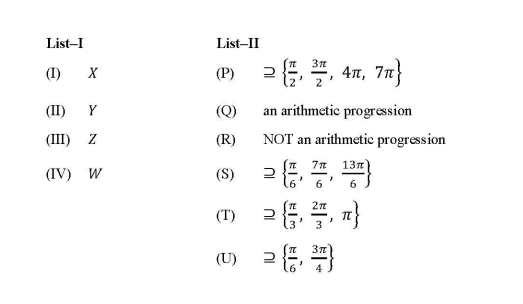Answer the following by appropriately matching the lists based on the information given in the paragraph.
Let f(x)=sin(πcosx) and g(x)=cos(2πsinx) be two functions defined for x>0. Define the following sets whose elements are written in the increasing order:
X={x:f(x)=0},Y={x:f′(x)=0},Z={x:g(x)=0},W={x:g′(x)=0}
List-I contains the sets X,Y,Z and W. List-II contains such some information regarding these sets:

Which of the following is the only CORRECT combinations?
(II),(R ), (S)
(I), (P), (R )
(II), (Q), (T)
(I), (Q), (U)
The correct Answer is:C
Step by step video, text & image solution for Answer the following by appropriately matching the lists based on the information given in the paragraph. Let f(x) = sin(picosx) and g(x)=cos(2pi sinx) be two functions defined for x gt0. Define the following sets whose elements are written in the increasing order: X={x:f(x)=0}, Y={x:f^(')(x)=0}, Z={x:g(x)=0}, W={x:g^(')(x)=0} List-I contains the sets X,Y,Z and W. List-II contains such some information regarding these sets: Which of the following is the only CORRECT combinations? by Maths experts to help you in doubts & scoring excellent marks in Class 11 exams.
Updated on:21/07/2023Topper's Solved these Questions
- BASIC MATHS,LOGARITHIM, TRIGNOMETRIC RATIO AND IDENTITIES AND TRIGNOMETRIC EQUATION BOOK - ALLENCHAPTER - BASIC MATHS,LOGARITHIM, TRIGNOMETRIC RATIO AND IDENTITIES AND TRIGNOMETRIC EQUATION EXERCISE - EXERCISE (JM)
16 Videos
- BASIC MATHS,LOGARITHIM, TRIGNOMETRIC RATIO AND IDENTITIES AND TRIGNOMETRIC EQUATION BOOK - ALLENCHAPTER - BASIC MATHS,LOGARITHIM, TRIGNOMETRIC RATIO AND IDENTITIES AND TRIGNOMETRIC EQUATION EXERCISE - EXERCISE (S-1)
44 Videos
- BASIC MATHS,LOGARITHIM, TRIGNOMETRIC RATIO AND IDENTITIES AND TRIGNOMETRIC EQUATION BOOK - ALLENCHAPTER - BASIC MATHS,LOGARITHIM, TRIGNOMETRIC RATIO AND IDENTITIES AND TRIGNOMETRIC EQUATION EXERCISE - EXERCISE (O-1)
55 Videos
- BASIC MATHS LOGARITHIM TRIGNOMETRIC RATIO AND IDENTITIES AND TRIGNOMETRIC EQUATION BOOK - ALLENCHAPTER - BASIC MATHS LOGARITHIM TRIGNOMETRIC RATIO AND IDENTITIES AND TRIGNOMETRIC EQUATION EXERCISE - ILLUSTRATIONS
39 Videos
- SOLUTION AND PROPERTIES OF TRIANGLEBOOK - ALLENCHAPTER - SOLUTION AND PROPERTIES OF TRIANGLEEXERCISE - All Questions
62 Videos
Similar Questions
Let f(x)= sin(πcosx) and g(x)=cos(1πsinx) e two function defined for x>0 define the following sets whose elements are written in increasing order.
X={x:f(x)=0},Y={x:f'(x)=0}
Z={x:g(x)=0},W={x:g'(x)=0}
List IList II(I) X(P) ⊇{π2,3π2,4π,7π}(II) Y(Q) an arithmetic progression(III) Z(R) not an arithmetic progression(IV) W(S) ⊇{π6,7π6,13π6}(T) ⊇{π3,2π3,π}(U) ⊇{π6,3π4}
Q.
View SolutionLet f'(sinx)<0 and f''(sinx)>0∀x∈(0,π2) andg(x)=f(sinx)+f(cosx), then
View Solution
Knowledge Check
Let f(x)=sin(πx) and D={x:f(x)>0), then D contains
A(13,12)B(15,14)C(−1,−12)D(−π,−12)A function f is defined by f(x)=xxsinx in [0,π]. Which of the following is not correct?
Af is continuous in [0,π]Bf is defferebtiable in (0,π)Cf(0)=f(π)DRolle's theorme is not applicable to f x on [0,π]Let f(x)= sin(πcosx) and g(x)=cos(1πsinx) e two function defined for x>0 define the following sets whose elements are written in increasing order.
X={x:f(x)=0},Y={x:f'(x)=0}
Z={x:g(x)=0},W={x:g'(x)=0}
List IList II(I) X(P) ⊇{π2,3π2,4π,7π}(II) Y(Q) an arithmetic progression(III) Z(R) not an arithmetic progression(IV) W(S) ⊇{π6,7π6,13π6}(T) ⊇{π3,2π3,π}(U) ⊇{π6,3π4}
Q. Which of th following is the only correct combinationAIV-(P),(R),(S)BIII-(R),(U)CIII-(P),(Q),(U)DIV-(Q),(T)
let f(x) =√x and g(x) =x be function defined over the set of non negative real numbers . find (f+g)(x),(fg)(x)and(fg)(x) .
View SolutionLet f(x)=√xand g(x)=xbe two functions defined over the set of nonnegative real numbers. Find (f+g)(x), (fg)(x), (fg)(x)and (fg)(x).
View SolutionLetf'(sinx)<0andf''(sinx)>0∀x∈(0,π2) and g(x) =f(sinx)+f(cosx)
which of the following is true?
View SolutionLet f''(x)>0∀x∈Randg(x)=f(2−x)+f(4+x). Then g(x) is increasing in
View SolutionThe function f defined as - f(x)=(sinx2)/x for x≠0 and f(0) = 0 is:
View Solution
